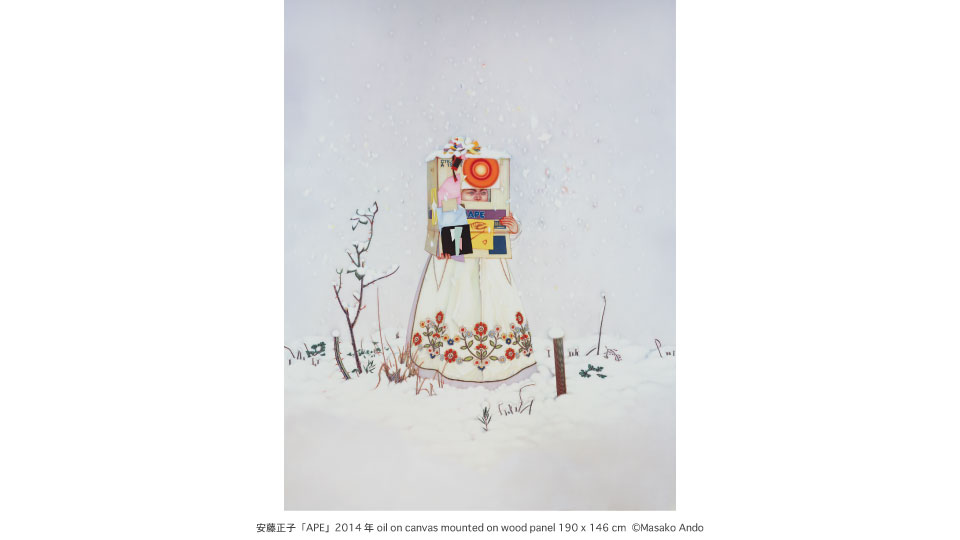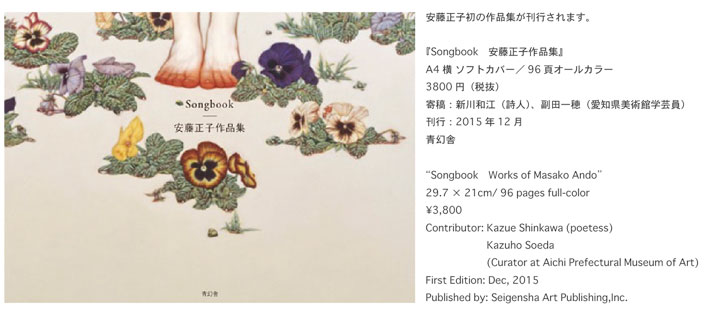
安藤正子 作品集刊行記念展「Songbook」Masako Ando “Songbook" Commemorating the release of her first art book
| 会 期 | 2016年1月13日(水) - 2016年2月 1日(月) |
|---|---|
| 時 間 | 11:00 - 20:00 |
| 場 所 | 8/ ART GALLERY/ Tomio Koyama Gallery |
| 料 金 | 入場無料 Admission Free |
オープニングレセプション中、安藤正子が作品集にサインを行います!

時代の波やスピードから一線を画し、現実とイメージの間で、丹念に絵づくりする安藤正子。本展覧会は、初の作品集が青幻舎から出版されることを記念し、掲載作品中から、新作ペインティングの「うさぎ」「パイン」「APE」三部作、ドローイングの「APE」、及び、今回の展示に合わせて作家自ら額を制作したドローイング「Light」を展示いたします。
新作「うさぎ」「パイン」「APE」は2011年の東日本大震災とそれに伴う原発事故の中、中部地方にて幼い子どもと暮らす作家の日常において、見聞きするニュースや混乱した現地の様子を受け止める過程で生まれました。人々が避難した後の無人の商店街を軽快に走り回るダチョウ、一本だけ残された松の木、すべてが流された海辺に廃材を集めて建てられた、アイヌ語で「火」を意味するという「アペ」という名のカフェ。新聞やニュースの映像などの情報と、子と共に段ボールで作ったロボットの頭、雪降る美しい冬の一日や父親の手描きの地図、草はらをかけてくる子と産まれなかった子、などなど数多の日常の出来事が蓄積し、それらが女性や子ども、彼らを取り囲む植物や身の回りの日用品などの形あるモチーフになって現れます。透明色、不透明色といった油絵具の特性を生かして絵と対話しながら作り上げられたその画面は、絵具の物質感や思考の過程、手作業の痕跡を丹念に消されることによって、鏡の中のような虚構性と、卓越した描写力による現実性、また、研ぎ澄まされた構図や表情による普遍性とが不思議に共存し、絵画の醍醐味を教えてくれます。
安藤正子は1976年、愛知県生まれ。2001年に愛知県立芸術大学大学院美術研究科油画専攻を修了しました。大学では、多くのアーティストに影響をあたえた櫃田伸也氏のもと制作を行い、現在は緑豊かな愛知県瀬戸市を拠点に制作を続けています。非常に時間を必要とする手法ゆえ作品は年数点というペースで制作され、今回の個展は2004年の小山登美夫ギャラリーでの初個展、「ハラ ドキュメンツ9 安藤正子 — おへその庭」(原美術館、12年)に続く三度目の個展となります。希有な機会であるこの展覧会を是非御高覧ください。
Distinguished from the trends of the time, Masako Ando works assiduously to create paintings that are able to express on the picture plane the gap between image and reality. For this exhibition, in celebration of her first art book published by Seigensha Art Publishing, Inc., a set of three new paintings “Hare”, “Pine”, and “APE” as well as drawings “APE” and “Light”, a drawing with her handmade frame, will be presented.
The new works “Hare”, “Pine”, and “APE” were created while the artist lived with her young child in the Chubu region, facing the disordered and chaotic appearance of the area of 2011 Tohoku earthquake and its associated nuclear disaster. Ostriches running wildly around deserted promenades; a pine tree left standing alone; a café named “APE”, which means ‘fire’ in the Ainu language, built with waste materials after everything was washed away from the seashore. Information from newspapers and images on TV broadcast screens; the heads of cardboard robots she made with her child; a beautiful winter day of snowfall; a map hand-drawn by her father; a child who ran to cross the fields; a child who was unborn. Great accumulations of daily occurrences are visualized as motifs such as women, children, the plants that surround them, and daily necessities. Taking full advantage of the unique properties of the oil paint medium such as its capacity for transparent and opaque hues, Ando makes a dialogue with her paintings. The process of contemplation and the materiality of the paints were carefully taken away from the works’ surfaces, and there mysteriously lie the mirrored fictitious world, depicted realistically with her highly remarkable skills, well-honed compositions and universally recognizable facial expressions. Thus, Ando’s works let us experience the true pleasure of painting.
Masako Ando was born in Aichi Prefecture in 1976. In 2001 she graduated from Aichi University of the Arts’ Graduate School of Oil Painting Department. While at university, she studied painting under Nobuya Hitsuda whose practice has influenced many artists, and now she continues to live and work based in the verdant setting of Seto city in Aichi Prefecture. Because of the extremely time-consuming techniques behind her art she works at a pace of several new pieces per year, and this exhibition marks her third solo show, following on from one in 2004 at Tomio Koyama Gallery, as well as “Hara Documents 9 Masako Ando: The Garden of Belly Button” (Hara Museum of Contemporary Art, Tokyo, 2012)








